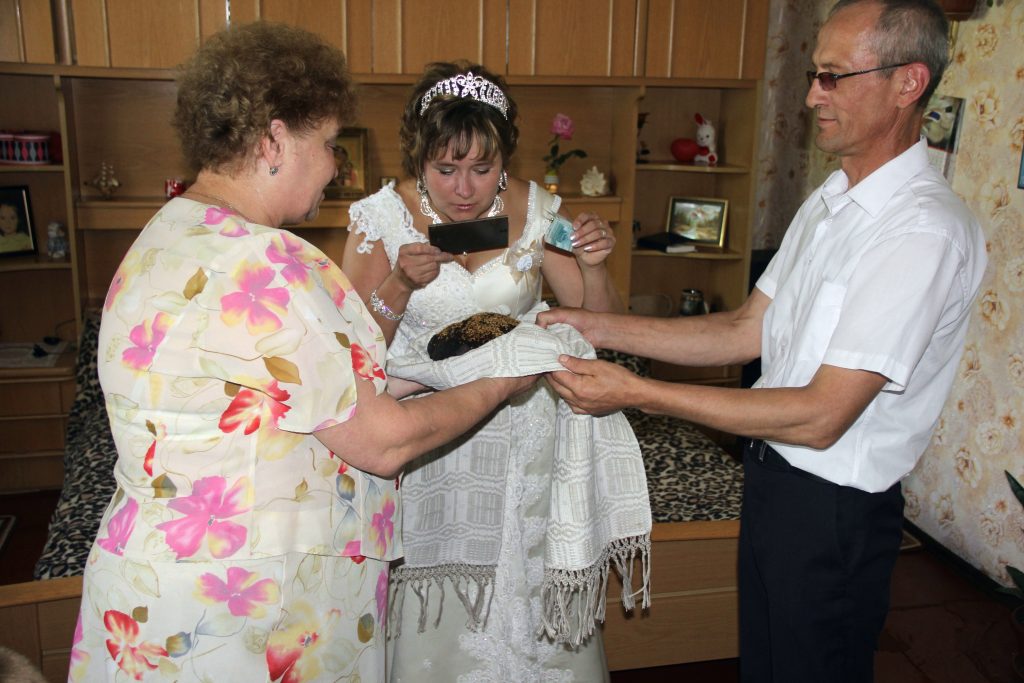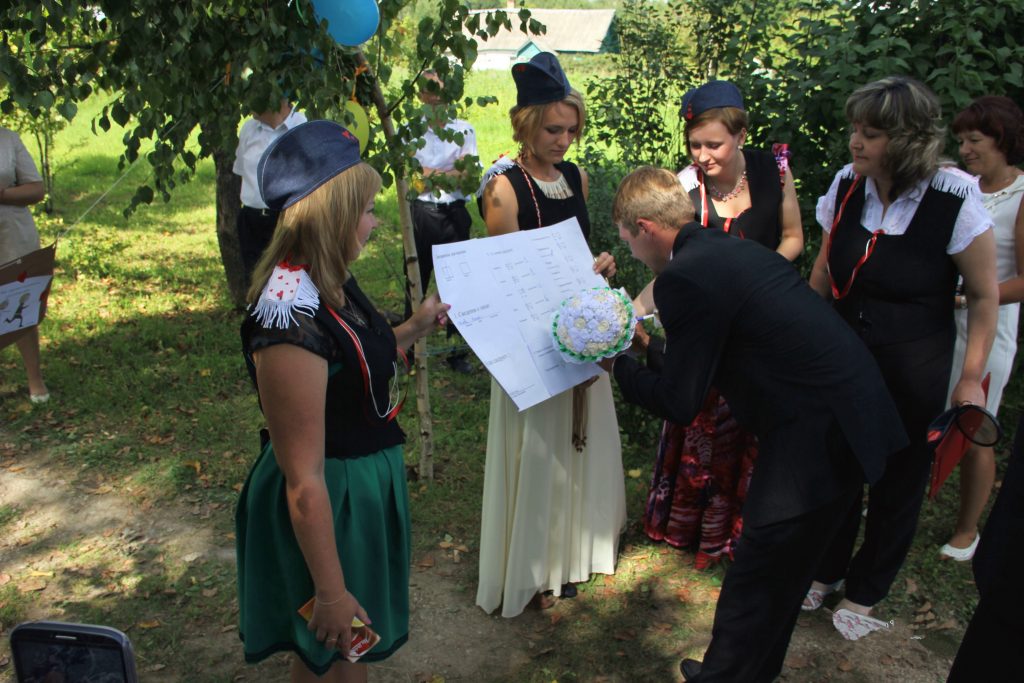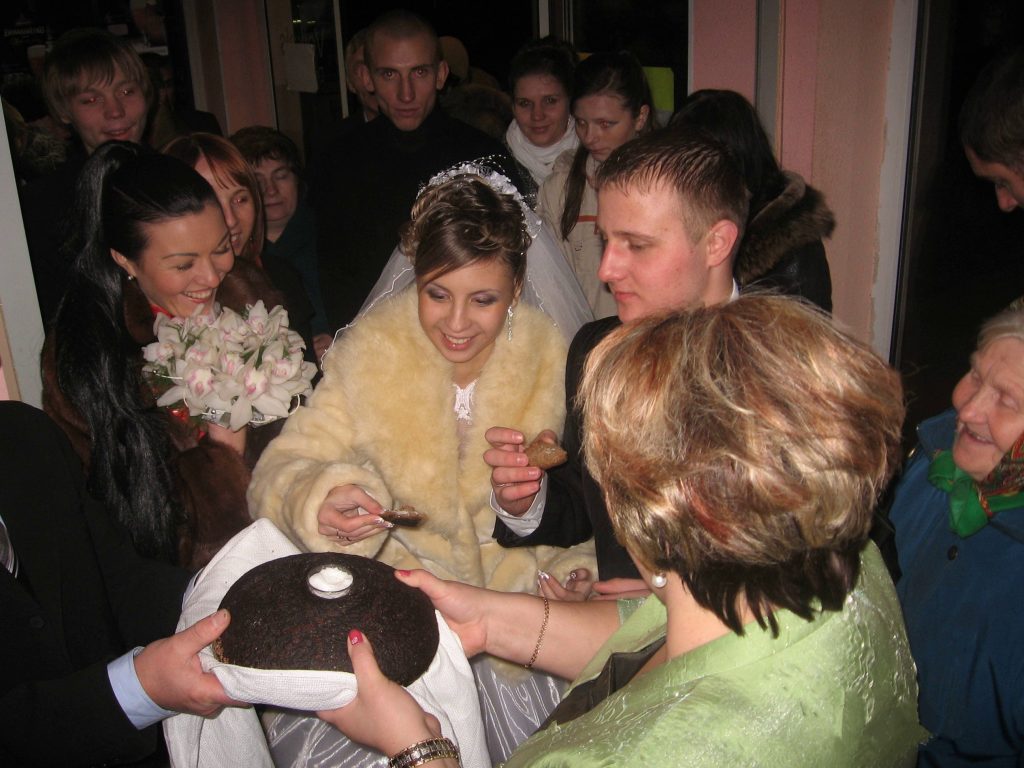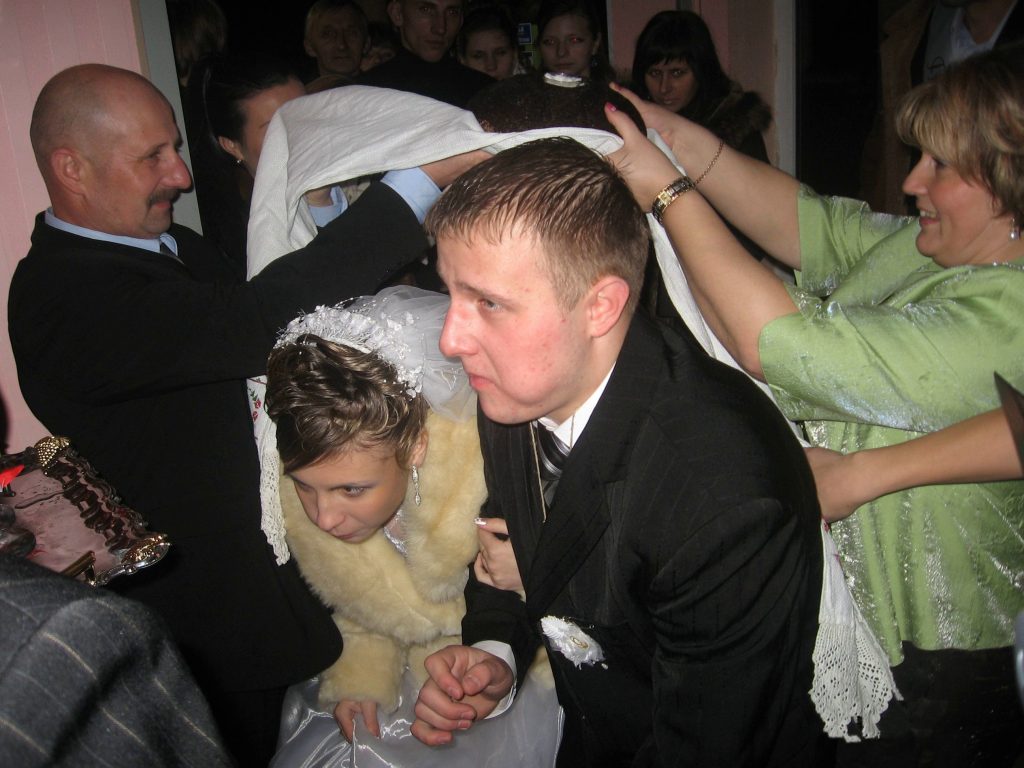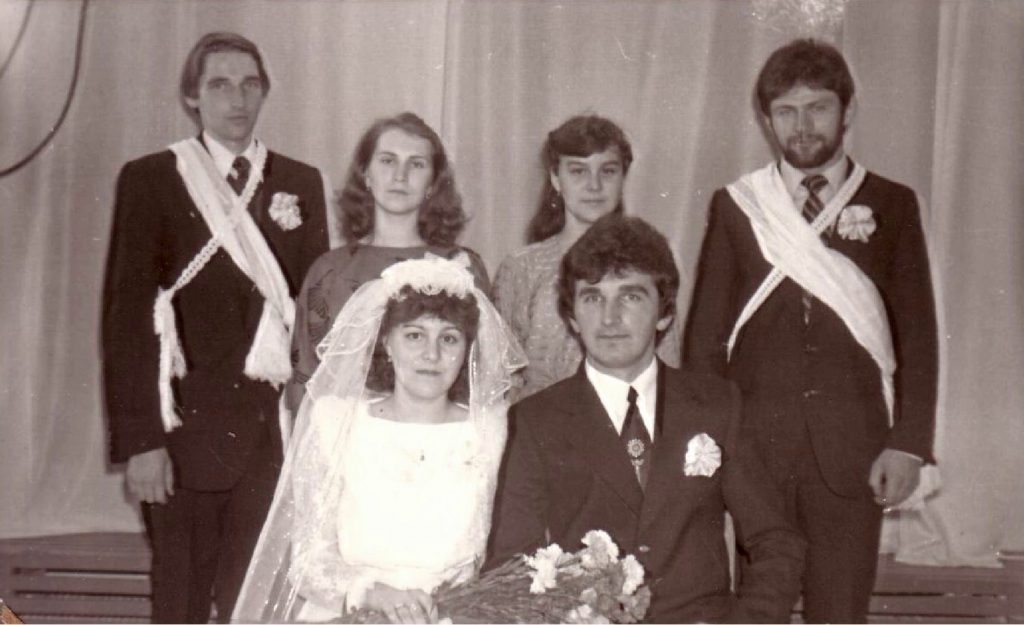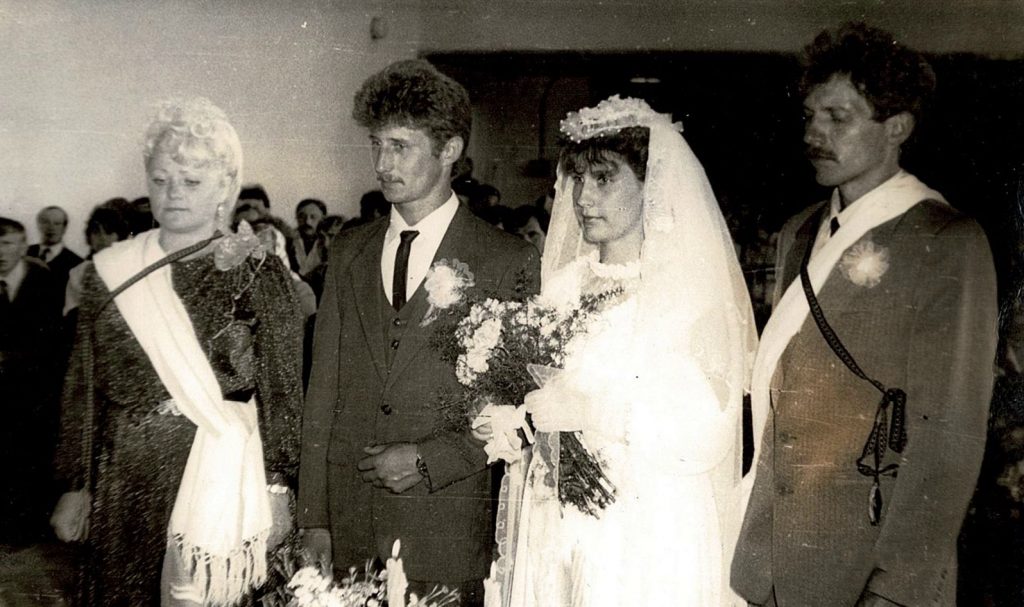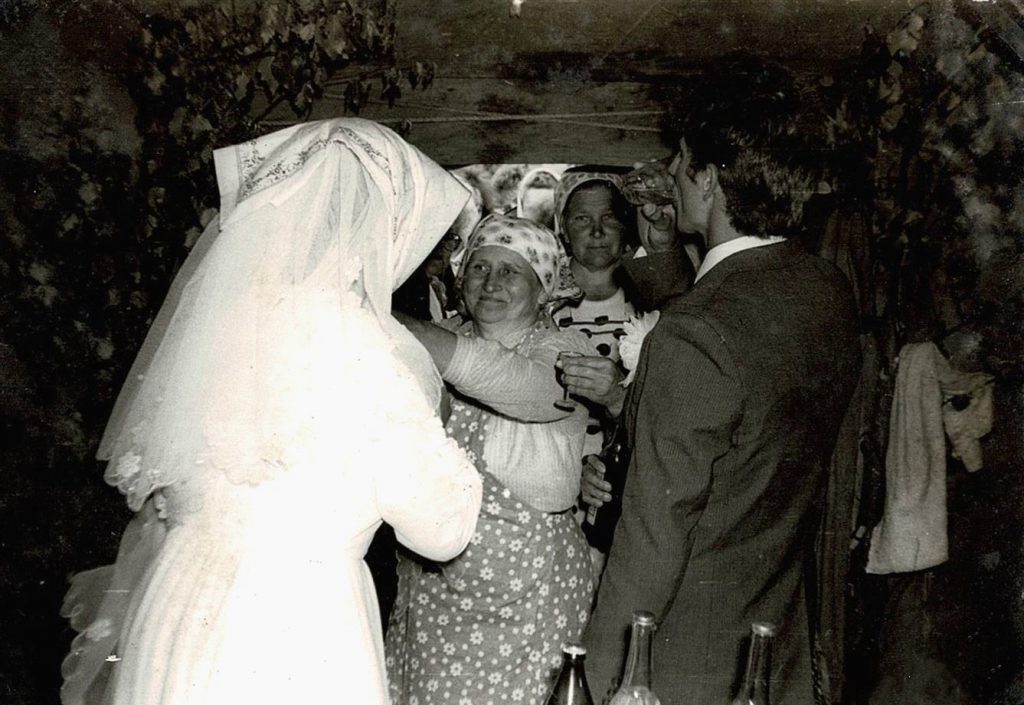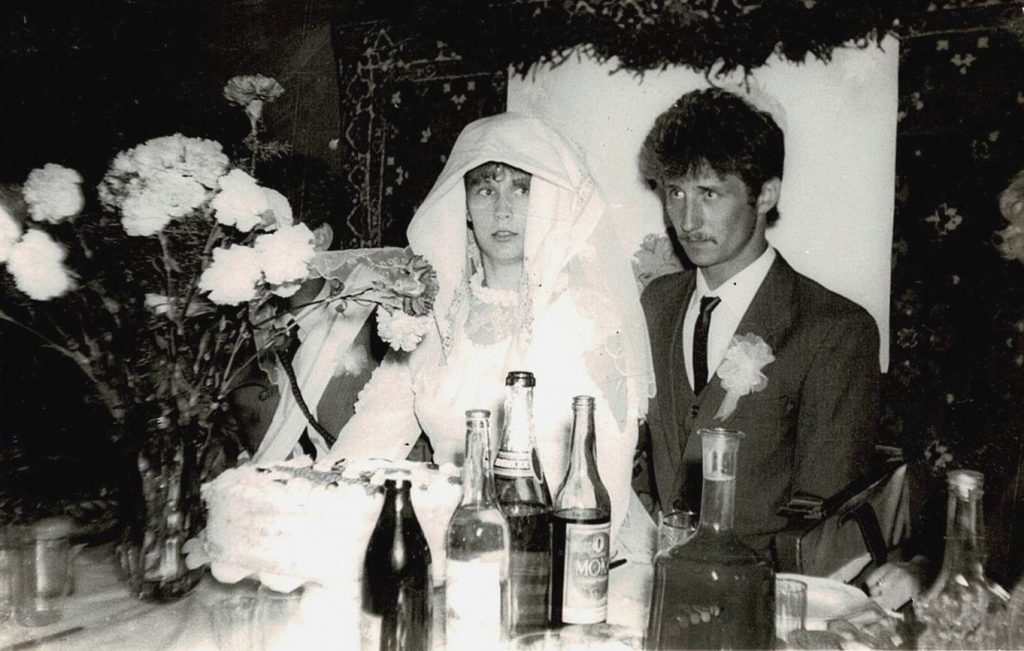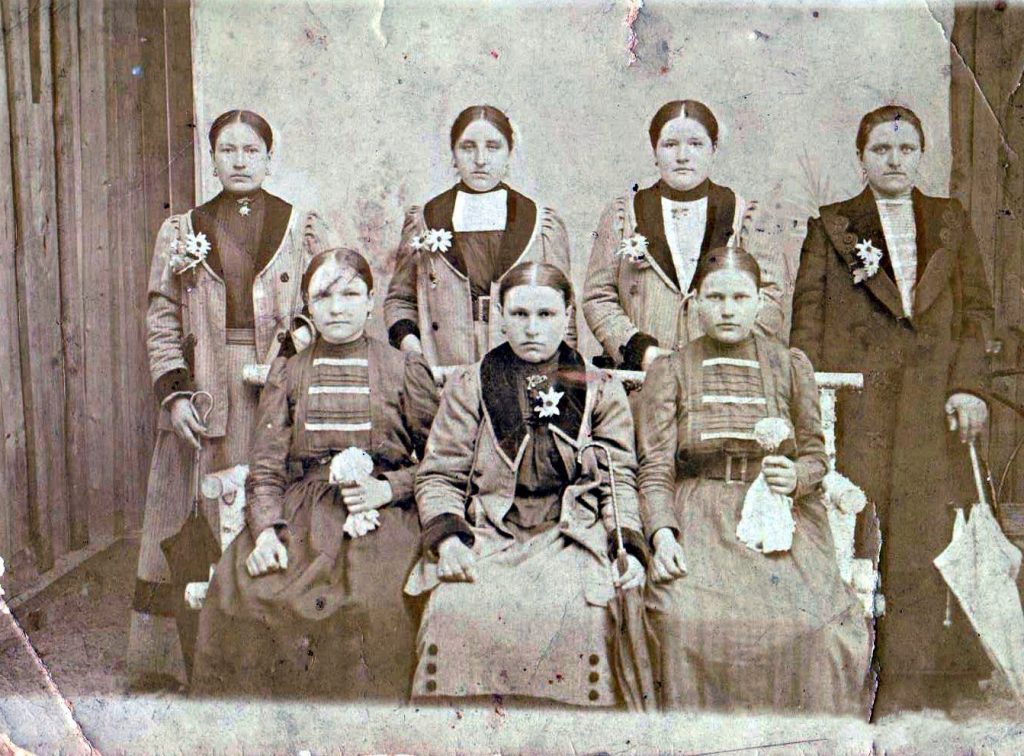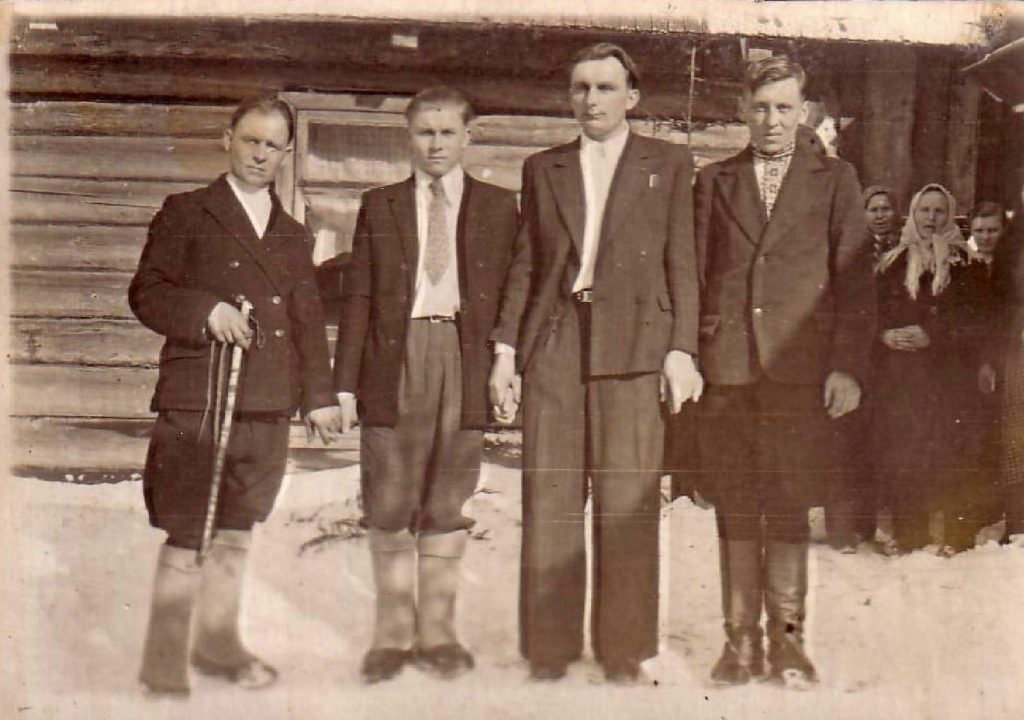Author:
Tatjana Steklova
Oral traditions and their expressions, including language as a vehicle of intangible cultural heritage
Social practices, rituals and festive events
Music/performing arts
Title
The Traditional Wedding Ritual of the Pededze Parish Eastern Orthodox believers (2019)
Педедзская свадьба по старинному.
Geography
Pededze Parish of the Alūksne Municipality. Local variations of the wedding ritual described here were documented in the Alūksne Municipality. Until recently, the wedding ritual described here was widespread in the entire parish and familiar to almost everyone. In the Balvi Municipality (Balvi Parish), Viļaka Municipality (Viļaka, Šķilbēni Parish), Baltinava Municipality (Baltinava Parish), Kārsava Municipality (Goliševa, Mērdzene Parish), and Ludza Municipality (Pilda Parish), the element was common only in specific places because these areas have a small Orthodox and Russian population.
The community consists of parish residents, members of a particular subethnic group, united by:
1. The local dialect which differs from the dialects spoken by other groups (for example, nearby groups across the Russian border); vocabulary formed as a result of direct translation from Latvian, for example, žuravina (журавина) – kļukva (kлюква): dzērvene [cranberry], razoraļi (разорали) – raspohaļi (распохали): uzara [ploughed], burki (бурки) – banki (банки): burkas [jars], barkan (баркан) – morkovj (морковь): burkāns [carrot].
Several decades of historical, economic, and cultural change in the life of the community have not developed or changed the language. For example, the following words are still in use: korņevatka (корневатка) – koka lūku grozs [bark basket], djanki (дянки) – dūraiņi [mittens], abrjažatsja (абряжатся) – apkopt lopus [tend livestock], tina (тина) – kartupeļu laksti [potato greens], srjašitsja (сряшиться) – neveikli pakrist [fall clumsily] etc.
2. A distinctive sense of identity that is reflected in cultural realities, traditions, festivities, rituals, songs, dances, and other forms of folklore.
3. Adherence to the Orthodox Church, which is reflected both in the social life of the community and in its folklore.
Importance in Community Life
Historically, the Orthodox Church in Pededze included not only ethnic Russians and Setu but also a significant number of Latvian families. As a result, a unique wedding ritual and a number of related activities came into being in the Pededze area.
Today, these wedding customs are of interest not only to parish residents but also to those who lived here in earlier times, and to anyone who has ever participated in this kind of wedding.
Many inhabitants of Pededze are partially familiar with these wedding traditions; some elements of this ritual are still used today.
Activities
The following elements are stillused in many cases: the proposal (svatovstvo, сватовствo); the agreement (govor, сговор); and the visits to the future relatives (smotrini, смотрины); together these are known as dimņičaņje (дымничанье). The marriage ceremony and dowry are almost obligatory.
Traditional wedding roles are still important in many weddings. These include the hosts of the wedding, the “družkas” of the bride and groom, the “brothers” of the groom, and the “girlfriends” or “sisters” of the bride.
The družkas, brothers, and hosts all wear wedding towels and sashes crossed over their chests.
On some occasions, družkas still contribute their epigrams and sayings, the bride and groom receive blessings from their parents, (наделяют и благославляют), who recite a prayer while holding a round loaf of bread and an icon over the newlyweds’ heads. The bride is still often “bought” from the bride’s sisters. As in ancient times, the newlyweds are led to a rug and seated on cushions at the table.
The “wedding train” is not a procession of horse-drawn carriages but of automobiles. It is an ancient tradition that the wedding cortège never takes the same route (for example, they take one route to the church, another to the registry office, and another back. They also have to cross a bridge).
This part of the tradition often involves setting up roadblocks to the “wedding train” and demanding ransom.
In preparation for the couple’s return from the church, the villagers build and decorate a gate at the newlyweds’ home, but block the path to the gate with a bench. The couple is seated on the bench and lifted up with shouts of "urā!". The groom’s parents greet them with bread and salt in outstretched arms. The bride is covered, then uncovered at the groom’s house, where the groom’s mother removes the veil. If possible, the newlyweds approach the table by walking over benches and chairs.
Bride stealing rituals are often employed, along with ransom demands for the return of the bride. On the second day, there is a purification ritual in the bathhouse; and, of course, the bride’s gifts to her new relatives.
Inheritance and transmission
Although the traditional order is not always followed, many of these ancient wedding rituals have endured.
Even recently, pesnohorki singers (песнохорки), who know the tradition and weddings songs, were still invited to many weddings.
At present, the most popular songs at a wedding in the Pededze parish are challenge songs, the baineičik song, the songs of the circle dance, and the song of congratulation to the bride and groom after the ceremonial "urā!".
History
For centuries Pededze parish was almost never within one territorial unit. Until 1782 it was divided between Russia, Poland, and Sweden; the stone cross in Silenieki, engraved with the date 1782, testifies to this history.
From 1782 to 1917, the parish belonged to the Russian Empire but was divided between three provinces – Pskov, Livland (Vidzeme), and Vitebsk.
From 1920 until 1923, most of Pededze belonged to Estonia, the rest to Latvia.
The current borders were established in 1924. Such changes in borders and governmental affiliations left their mark on traditions, customs, and even social life, including the Orthodox wedding ritual.
Historically and culturally, the Orthodox wedding rituals of the eastern region of Latvia are closely related to wedding traditions in the Pechory region of the Pskov province and those of the central Pskov region.
The wedding ritual with all its artistic forms, including speeches (prigovori, pričitaņija; приговоры, причитания), songs, and dances, occupies a dominant place in the traditional culture of the Russian Orthodox population of eastern Latvia.
Weddings, along with calendrical festivities such as Christmas, Masļeņica, and Troica, through instrumental and choreographic culture, (gusli, accordions, fiddle; various male, female, and mixed choreographic forms) are an important feature of Orthodox Russian subethnic uniqueness.
It is important to note that of all the traditions mentioned here, the wedding ritual has survived with the least amount of change, and many of its forms are still popular among the people of this region.
Additional Information
1. Women’s handicrafts are an integral part of the wedding ritual, including:
* Woven fabrics (canvas, festive and everyday towels, rugs, sashes).
* Embroidered textiles (tablecloths, towels, women’s clothing, bed linens).
* Knitted and crocheted fabrics (tablecloths, lace, mittens, gloves, socks, clothing).
Many of these serve as ritual objects and as part of the dowry, etc.
2. There are also traditional wedding foods associated with the ritual, including special bread, beer, and moonshine.
3. The traditional tasks involved in preparing for the wedding are also important, including securing the rooms and the horse and carriage, and constructing the wedding gate.
4. It is also important to know the rules and canons of the Orthodox Church.
5. Oral folklore. The entire process is led by the družka, in poetic language and in the local dialect, employing imaginative epigrams (e.g., ņevesta, utuška – невеста, утушка) and Orthodox scripture.
All rituals are accompanied by songs or readings (pričeti – причеты). There is challenge singing and svadebnie veļičaļnie (свадебные величальные) chanting. Practically the entire ritual is accompanied by women’s circle dances. There is a large repertoire of circle dance songs and texts.
Traditional music. Accordion and balalaika players must participate. Three-row accordions of the German type (pēterburģenes) are especially popular, as are the Ieviņš-type harmonica (Петроградка, Ивушка).
6. Folk beliefs have always been an indispensable part of the wedding ritual.
* It is a bad sign if someone walks between the newlyweds, steps on, or otherwise soils the bride’s dress or veil.
* When the couple first meets, whoever first steps on the other’s toes will take the upper hand when they quarrel.
* When entering the church, the bride must drag her heel over the threshold. To ensure successful childbirth, the bride must not tie a belt around her dress before the wedding.
* During the wedding ceremony, looking at the images of angels in the icons will make their children beautiful.
* After entering the groom’s house and tasting the bread and salt, the bride must place a pair of mittens on the bread as a gift to her mother-in-law to ensure her good will.
* There must be enough mittens and socks in the dowry to last for ten years because in the first years after the wedding, children will be born and there won’t be time to knit.
* Wedding guests must try not to take the same routes, so that the couple doesn’t tire of each other. They also have to drive over a bridge because the bride must throw a belt into the river so that she doesn’t have to shed tears in her marriage.
Masters
Tatjana Steklova (b. 1966) from Pededze,
Antoņina Girs (b. 1953) from Pededze,
Yevgenia Rozina (b. 1926) from Rīga,
Yevgenia Illarionova (b. 1944) from Pededze,
Zinaida Kručkova (b. 1939) from Pededze,
Marija Pavlova (b. 1935) from Pededze,
Inese Volšteina (b. 1969) from Pededze,
Ludmila Uglovska (b. 1970) from Pededze,
Tatjana Krutina (b. 1969) from Pededze,
Antoņina Kaminskaja (b. 1944) from Pededze,
Inta Ņikitina (b. 1950) from Pededze.
Many people in Pededze are at least partially familiar with these wedding traditions.
Institutions and Organizations
Alūksne municipality Pededze People’s House;
FPC Tradīcija.
Strengthening the Tradition
In 2014, with the support of the Pededze People’s House (Tatjana Steklova) and Pededze Museum (Inese Volšteina) of the Alūksne Municipality, the research project “Russian Wedding Traditions in the Pededze Parish in the Late 19th and Early 20th Centuries” was developed. As part of the project, old wedding photos were collected, memories of old residents were recorded, a wedding dress from the early 20th century was found and restored, a bridegroom’s shirt and other clothes, belts, towels, gloves, and other ancient household items of the Pededze area, which are part of the Pededze People’s House permanent exhibit “Everyday Life in Old Pededze” and photo exhibit “Latvia’s Centenary.”
In 2014, the association “The Future of Pededze” and the Pededze People's House organized a traditional Pededze wedding celebration as part of the project “Historical Wedding traditions in Pededze. Past and Nowadays” supported by the Valmiera municipality Foundation and the Ministry of Culture. The wedding ceremony played at the event was recorded on DVD, the recording is at the disposal of the association, and was given to the project's collaborators.
In 2015, the Pededze Library and the Pededze People’s House (T. Steklova, A. Gir) put together a dictionary of the most peculiar words of the local dialect (a copy is available at the People’s House).
The association FPC Tradīcija (Chairman of the Board S. Olenkin) has conducted several folklore expeditions in the Pededze Parish. The collected materials have been included in the audio and video archive of FPC Tradīcija. During the expedition, folklore material was discovered and documented, including the wedding folklore of said parishes, which has been partially preserved to the present day. Some of the materials of the expedition have been published in S. Olenkin’s book Russian and Belarusian Folkore in Latvia at the Turn of the Millennium. (“Русский и белорусский фольклор в Латвии на рубеже тысячелетий”).
A documentary “Russian Wedding in Latgale. Morning in the Bride's House” has been made. Screenwriter S. Olenkin, director N. Stratanovich. The documentary footage was taken in the Pededze Parish of the Alūksne Municipality.
The folklore ensemble Iljinskaya Pjatņica has gained considerable experience in reconstructing, learning, and performing the traditional wedding rituals.
What has been done over the last five years to ensure the existence of the Element.
2019/2020 - exhibitions at the Pededze People’s House:
* “The Orthodox Wedding in Pededze”;
* “Ancient Musical Instruments”;
* “From Grandma’s Dowry Chest”.
2020 – Forum at the Pededze People’s House “Oh, This Pededze Wedding...” (partially withdrawn due to the Covid-related restrictions).
2020 – introduction and training (masterclasses) at the Pededze People’s House “Workshop for the Soul: Scarf Weaving” (the scarves were used as ritual objects from the dowry).
2020 – “Tell Me about Yourself” project - Intercultural dialogue in Vidzeme 2020.
A tablet-sign has been installed on the wall of the parish management building. The project is being implemented by the Future of Pededze Association, the Valmiera Municipality Foundation and the Ministry of Culture.
2021 – Project “Pededze Wedding Materials.” The project was implemented by the association FPC Tradīcija, with the support from the State Culture Capital Foundation.
2022–2023 – Project “Transformation of the Wedding ritual of the Pededze Orthodox Residents into the Contemporary Community Theater Performance ‘Weddings, Kогда-то’” (the title was changed to “Sateka” – Confluence). The project was implemented by the Future of Pededze Association, the foundation INITIUM, and “Eguilibrium Group”, with the support from the British Council Latvia, Vidzeme Planning Region, Latvian State Forests, State Culture Capital Foundation, and the Alūksne Municipality.
2023 – Singalong at the Pededze People’s House “Wedding Songs at the Table.”
The above activities have fueled interest among parish residents in the local folklore and wedding rituals. For the preservation of cultural intangible heritage, the event participants, especially young people, gained new knowledge and skills in the acquisition of ancient traditions and customs. The development and preservation of unique forms of folklore material with a view to passing them down to future generations has been promoted. Through the exploration of the culture and history of their parish and region a sense of pride in their “little homeland” has been instilled in the youth.
Support from State and local government institutions or other entities hitherto received and planned:
2019/2020
Exhibitions at the Pededze People’s House:
* “Orthodox Wedding in Pededzé”
* “Ancient musical instruments”
* “From Grandma’s Dowry Chest”
€20.00 from the Pededze People’s House budget
2020
Forum at Pededze People’s House “Oh, This Pededze Wedding...” (partially cancelled due to Covid-related restrictions)
EUR 700.00 Alūksne Municipality
2020
Introduction and training (masterclasses) at the Pededze People’s House “Workshop for the Soul: Scarf Weaving”.
€70. 00 from the Pededze People’s House budget
2020
Project “Tell Me about Yourself: the Intercultural Dialogue in Vidzeme 2020”. The sign/plaque installed on the parish administration building.
EUR 1300.00 Future of Pededze Association, Valmiera Municipality Fund, and Ministry of Culture
2021
Project “Pededze Wedding Materials”
EUR 5000.00 society FPC Tradīcija, State Culture Capital Foundation
2022-2023
Project "Transformation of the Wedding Ritual of Orthodox Residents of Pededze into the Contemporary Community Theatre Performance ‘Weddings, Kогда-то’ “(title changed to “Sateka” – “Confluence”).
EUR 6000.00 Future of Pededze Association, INITIUM Foundation and Eguilibrium Group, British Council Latvia, Vidzeme Planning Region, Latvian State Forests, State Culture Capital Foundation, and Alūksne Municipality .
2023
Singalong at the Pededze People’s House “Wedding Songs at the Table”
€100.00 from the Pededze People’s House budget
Continuity/Development
Measures planned for documentation and research of the Element:
Using the new technologies, create a structured document and material accounting system in 2025 that would be simple and transparent. From the Pededze People’s House budget.
in 2026–2027, on the basis of the developed materials and documents:
* plan;
* further develop the documents themselves;
* publish the material on social media and on the Alūksne Municipality government homepage;
* create booklets and brochures.
Organization of masterclasses:
* production of video and photo material based on masterclass events;
* publish and promote videos and photos on social media.
From the budget of Pededze People’s House, and State Culture Capital Foundation funds.
in 2027–2030, acquisition of interactive and multimedia technologies for the introduction of educational games.
State Culture Capital Foundation.
Measures planned for the safeguarding and developing of the Element:
In 2025, a three-day seminar called “Oh, This Pededze Wedding...”
Introduction to traditional folk performing arts and training (masterclasses) in the following areas:
* Folksongs: masterclass “Correct Singing at Weddings,” with S. Olenkin and folklore ensemble “Iljinskaja Pjatņica.”
* Folk dancing: a masterclass in “Local Dances of Pededze,” with L. Uglovska and L. Bundzena and the Kaimiņi dance group.
* Folk games (including traditional games and competitions).
Tatjana Steklova, a specialist at Alūksne Culture Center for Jaunalūksne and Pededze.
A lecture-concert “Stage Wedding Song” in 2025 (promotion and preservation of traditions, interests, and mutually respectful relationships).
Tatjana Steklova, a specialist at Alūksne Culture Center for Jaunalūksne and Pededze.
In 2026, the forum-seminar “Oh, This Wedding...” with a folk costume procession “Ethnofashion” (introduction to the wedding traditions and folk costumes of the Alūksne Municipality, Latvia, and ethnic minorities, application of elements of folk costumes in modern fashion with the aim of attracting young people’s interest; synergy of national cultures).
Tatjana Steklova, a specialist at Alūksne Culture Center for Jaunalūksne and Pededze.
In 2027–2029, publication of the brochure “Historical Pededze Wedding” – for advertising, introduction, information, and business purposes.
Tatjana Steklova, a specialist at Alūksne Culture Center for Jaunalūksne and Pededze.
In 2027-2029, the acquisition of interactive and multimedia technologies for the introduction of educational games. The information will be presented to a variety of audiences, especially young people in an exciting form, making it easy to remember.
Tatjana Steklova, a specialist at Alūksne Culture Center for Jaunalūksne and Pededze.
The objectives of the above measures shall be the preservation and promotion of intangible and tangible cultural heritage through the following tasks:
* involve the youth and middle generation of Pededze in the acquisition and development of local traditions;
* promote traditions of, interest in and respect for ethnic cultures;
* promote the importance of revitalizing cultural heritage as an asset;
* develop tourism in Pededze as an asset in learning about the aesthetic and artistic heritage.
Threats to the Tradition
At present, the preservation of the traditional wedding rituals Pededze parish will not be possible without academic research, the support of researchers, and financial support from organizations interested in the preservation of this intangible cultural heritage.
The lack of such support will threaten the ritual’s survival and its passing on to future generations.
It is important to note that people are constantly moving away from rural areas, resulting in a decline in cultural activities for the remaining community. Therefore, additional efforts are needed to promote cultural life in the community, organizing traditional festivals, folk group concerts, etc.
We are convinced that by researching and introducing these traditions to the people of the parish, the repertoire of songs required at weddings would increase considerably.
Unfortunately, local residents who are fluent singers are no longer able to participate in weddings due to their advanced age.
There are women of the middle and younger generations who would like to study the wedding traditions and acquire the singing skills needed for traditional weddings.
The director of the FPC Tradīcija [Tradition] Centre Sergey Olenkin and members of the authentic folklore studio and folklore group Iļjinskaja Pjatņica are ready to organize training sessions on wedding customs and master classes to teach traditional wedding singing skills.
Applicant
Biedrība Pededzes Nākotne, reg. no. 40008051202
Photo Gallery
Audio Materials
Video Materials
Text Materials
Publications
Народная традиционная культура Псковской области: Обзор экспедиционных материалов из научных фондов Фольклорно–этнографического центра: В 2 т./Сост., науч. ред. А. М. Мехнецов. – СПб.; Псков: Изд–во Псковск. обл. центра народного творчества, 2002. Т. 1. – 688 с.; Т. 2. – 816 с.: нот.
Фридрих И. Д. Фольклор русских крестьян Яунлатгальского уезда. Кн. 1. Песни: Детские, хороводные, беседные, обрядовые, заговоры и духовные стихи и др./Собраны И. Д. Фридрихом; под ред. П. Шмита; фоногр. записи мелодий на ноты переложены М. Гривским – Riga: issued cultural foundation, 1936 – 527 с.
И.Д.Фридрих “Русский фольклор в Латвии: песни, обряды, детский фольклор”. Рига. “Лиесма”. 1972 г. 485 стр
М.Шпис “Свадебные песни и обряды”. Собственное издание. 1936 год
С.А.Оленкин “Русский и белорусский фольклор в Латвии на рубеже тысячелетий”. Рига. “Golden autumn”. 2017 г. 300 стр. нот.


